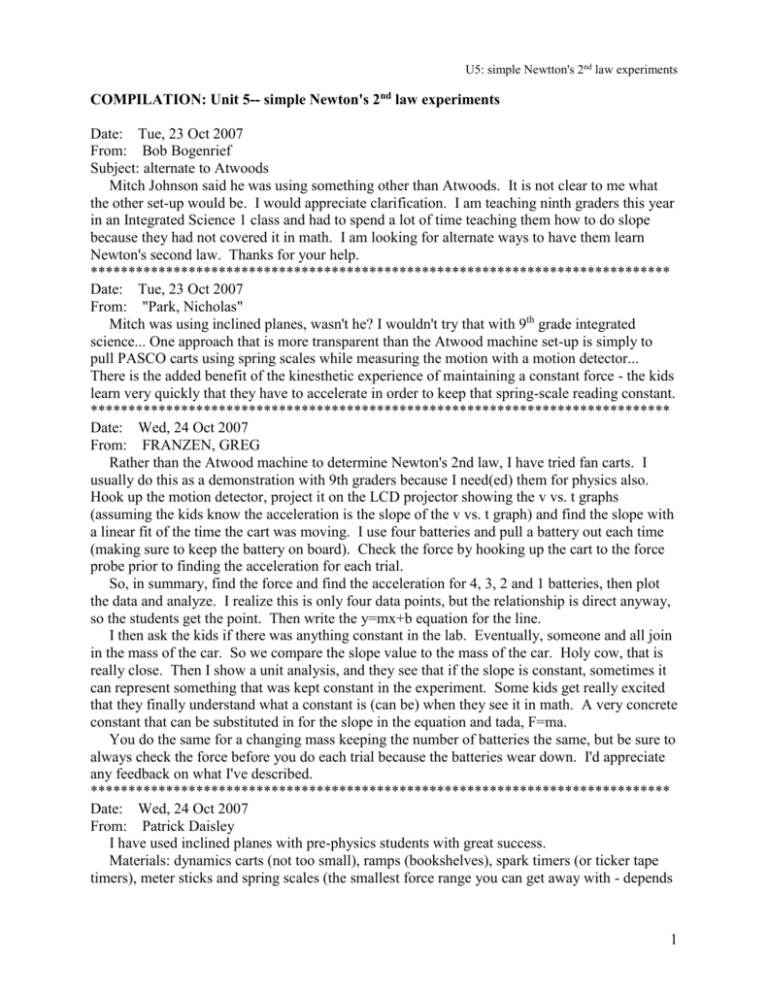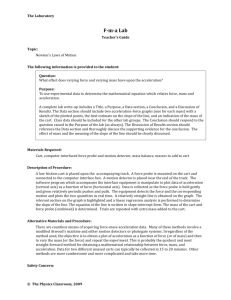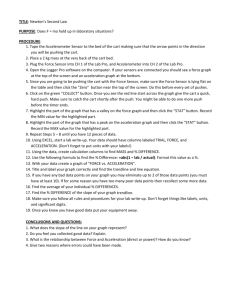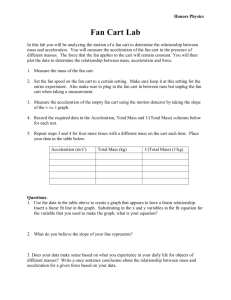Unit 5 -Conceptually Simple Newton's 2nd Law Labs
advertisement

U5: simple Newtton's 2nd law experiments COMPILATION: Unit 5-- simple Newton's 2nd law experiments Date: Tue, 23 Oct 2007 From: Bob Bogenrief Subject: alternate to Atwoods Mitch Johnson said he was using something other than Atwoods. It is not clear to me what the other set-up would be. I would appreciate clarification. I am teaching ninth graders this year in an Integrated Science 1 class and had to spend a lot of time teaching them how to do slope because they had not covered it in math. I am looking for alternate ways to have them learn Newton's second law. Thanks for your help. ***************************************************************************** Date: Tue, 23 Oct 2007 From: "Park, Nicholas" Mitch was using inclined planes, wasn't he? I wouldn't try that with 9th grade integrated science... One approach that is more transparent than the Atwood machine set-up is simply to pull PASCO carts using spring scales while measuring the motion with a motion detector... There is the added benefit of the kinesthetic experience of maintaining a constant force - the kids learn very quickly that they have to accelerate in order to keep that spring-scale reading constant. ***************************************************************************** Date: Wed, 24 Oct 2007 From: FRANZEN, GREG Rather than the Atwood machine to determine Newton's 2nd law, I have tried fan carts. I usually do this as a demonstration with 9th graders because I need(ed) them for physics also. Hook up the motion detector, project it on the LCD projector showing the v vs. t graphs (assuming the kids know the acceleration is the slope of the v vs. t graph) and find the slope with a linear fit of the time the cart was moving. I use four batteries and pull a battery out each time (making sure to keep the battery on board). Check the force by hooking up the cart to the force probe prior to finding the acceleration for each trial. So, in summary, find the force and find the acceleration for 4, 3, 2 and 1 batteries, then plot the data and analyze. I realize this is only four data points, but the relationship is direct anyway, so the students get the point. Then write the y=mx+b equation for the line. I then ask the kids if there was anything constant in the lab. Eventually, someone and all join in the mass of the car. So we compare the slope value to the mass of the car. Holy cow, that is really close. Then I show a unit analysis, and they see that if the slope is constant, sometimes it can represent something that was kept constant in the experiment. Some kids get really excited that they finally understand what a constant is (can be) when they see it in math. A very concrete constant that can be substituted in for the slope in the equation and tada, F=ma. You do the same for a changing mass keeping the number of batteries the same, but be sure to always check the force before you do each trial because the batteries wear down. I'd appreciate any feedback on what I've described. ***************************************************************************** Date: Wed, 24 Oct 2007 From: Patrick Daisley I have used inclined planes with pre-physics students with great success. Materials: dynamics carts (not too small), ramps (bookshelves), spark timers (or ticker tape timers), meter sticks and spring scales (the smallest force range you can get away with - depends 1 U5: simple Newtton's 2nd law experiments on the mass of your carts). You could also use stopwatches (not too accurate) or photogates if you just want to time the cart for a set displacement and assume a constant acceleration. To vary the force, just raise one end of the ramp. Use the spring scale, held parallel to the ramp, to measure the NET force on the cart. Use the spark timer and tape to record and measure positions and clock readings for a graph. The tape can also be used to create a velocity graph of the motion--probably more useful since you're trying to derive acceleration proportional to net force. To see the effect of changing mass you add mass to the cart and then adjust the angle of the ramp so that the net force, as measured by the spring scale (or force probe for that matter), is the same for each trial. The spark timer (or whatever) is again used to collect data. I think the advantage with this approach is that it's fairly concrete without the abstract complication of trying to explain why the tension in the string isn't the same as the weight of the hanging mass. You can directly measure the net force and positions and/or (nearly) instantaneous velocities. ***************************************************************************** Date: Thu, 25 Oct 2007 From: Vonnie Hicks With the discussion of Atwood machines, ramps, and Newtons 2nd, I am compelled to share my favorite deployment activity for physical science (and some physics) students: I use 'human dynamics carts' which can be anything from skateboards to rolling chairs to platform carts with skateboard wheels (my human dynamics cart). Using 40 newton spring scales (usually large springs for holding truck tarpaulins down, calibrated by the students in an earlier lab) the students pull a cart loaded with a student. There are two runs - one in which the student/cart is pulled at constant speed to determine the friction force, and a second in which the scale is made to maintain a preset value as the student/cart combination is accelerated across the floor. A motion detector can measure velocity vs time, allowing the slope to provide acceleration (I have also had the accelerating students dot on the floor with a marker in time to half-second metronome claps or students clapping every half-cycle of a 25 cm pendulum, but the motion detector is more time-effective). With applications of Newton's second, the students can calculate the mass of the student-cart combination, then verify by having the student hold the cart while standing on a bathroom scale. Results are usually within 5%, once they recognize the need to subtract friction force from applied force. ***************************************************************************** Date: Fri, 26 Oct 2007 From: Andy Edington Regarding the fan cart for a vs F, I do the same thing with my ninth grade "General" Physical Science class...and also with my "Honors" Physics classes. The modified Atwood’s machine setup used in physics does not make the relationship clear for some students; they get confused by the setup and lose track of the "main thing." I once tried rigging the fan unit with a 6-cell battery pack. More than 4 cells - too much vibration. I've thought about setting up a high wattage potentiometer to allow variable force, but I have never gotten around to it. ***************************************************************************** Date: Sun, 28 Oct 2007 From: mitchell johnson I would not think that 9th graders could do the trig for that. Even my regular students are so 2 U5: simple Newtton's 2nd law experiments low in math that I do not require them to do more than 45-45-90 and 30-60-90 triangles and they will do the modified Atwood. We do NSL on the incline where net force is the independent and acceleration is the dependent. This is after force components lab where one force sensor is at the top of the ramp parallel to the track and the other force sensor is perpendicular to the track where the cart is just pulled off of the track so it is supported by both sensors. They then go from 0 to 90 degrees so they can see the sin and cos curves which they use to linearize the graph. 45 degrees is fun because the sum there is way more than the Fg on the cart. ***************************************************************************** Date: Mon, 29 Oct 2007 From: Matt Greenwolfe I learned a nice version of this from John Makous and Joe Mahler, modelers from Providence Day School in Charlotte, NC. They simply pull a Pasco cart with a rubber band, being careful to keep the stretch constant. Measure the force with a force sensor while the cart is at rest, and use a motion sensor to produce a v-t graph. I got some brass rods and put some plastic shelf-bracket covers on the ends (for safety). Tape the rods to the cart and pull the rubber band until the end of the rubber band is even with the end of the rod. This helped to keep the force constant. Just slide the rod forward or back to change the force. ***************************************************************************** Date: Mon, 29 Oct 2007 From: Rob Spencer Thanks for that description. I think this is a wonderful idea. Would a loose spring work better since rubber bands are non-Hookean? We just did a lab in AP C in which the students loaded up springs and rubber bands with hanging mass and then unloaded the masses. You get different values for the stretch for a given force depending on loading or unloading. I suppose that this doesn't add unmanageable error since y'all are doing it with success. Obviously, rubber bands would be MUCH easier to work with due to their availability and students' experience with them. Just curious, have you tried using springs here? ***************************************************************************** Date: Mon, 29 Oct 2007 From: Matt Greenwolfe John and Joe have done it successfully with rubber bands for several years. Last year I did it with some loose springs (the ones that came with the Pasco tracks) and they also worked fine. The data is not as clean as you get from the Atwood's machine, so you have to play with the apparatus yourself in advance and figure out its quirks so you can advise the students on how to take careful data. But in all cases, they could see the direct and inverse fits with no problem. I haven't had a fan cart to try, but it sounds like a very similar idea and it probably does a better job of keeping the force constant so that you get better data. ***************************************************************************** Date: Thu, 1 Nov 2007 From: Liz QuinnStine Rob Spencer asked “Would a loose spring work better since rubber bands are non-Hookean?" I also did this lab last year. Although keeping the rubber bands (or springs) stretched a constant amount can be a challenge, it doesn't matter that the rubber bands are non-hookean since you measure the force directly with the force sensor. ***************************************************************************** 3 U5: simple Newtton's 2nd law experiments Date: Tue, 30 Oct 2007 From: Andy Edington The "old-school" method was to use the "roller skate" carts, loading them with bricks to change the mass. The carts were pulled across the floor with rubber bands that were about 30cm long relaxed. A meter stick was used to stretch the bands to a roughly constant length while pulling the carts. Paper tickertapes or average velocity was used to determine the acceleration. The large masses "hid" the rubber band stretch variations that occurred. The force on the cart by the rubber band was determined with a spring scale. The cart could be pulled with a spring scale, but it was easier to run along behind the cart "pushing" the rubber band with a meter stick. I haven't done this in years, but I may try it out this year using the motion detectors. ***************************************************************************** Date: Fri, 2 Nov 2007 From: Joseph Mahler For the NSL lab I used to use rubber bands attached to a force probe that was fixed onto a lab cart. I then use a motion detector to measure the acceleration of the cart. The computer displays two graphs, force vs time and velocity vs time. The students highlight the portion of the velocitytime graph that corresponds to when the cart was accelerating. They then use the computer to determine the slope for that portion, getting the cart's acceleration. They then highlight the same time frame in their force vs time graph and have the computer determine the mean force acting on the cart while it is accelerating. [I emphasize to the students that v-t graph must be linear, constant acceleration, and the f-t graph must be a horizontal line, constant force.] As many people have pointed out, it is hard to keep the rubber band at a constant stretch. During our workshop this summer John Makous and I discovered that the bands used to hold name tags around your neck work great. The bands [they are white and come with Avery name tags] are very flexible, so any small difference in stretch length does not produce a big difference in the amount of force the band exerts on the cart. Using the Avery name tag bands I got the best result for this lab that I have ever gotten. When the students graphed Acceleration vs Unbalanced Force [when we do this lab we assume friction not to be present and then come back and talk about why our results are not exactly what we thought they should be] the inverse of their slopes were only 2-3% off the mass of the carts and their y-intercepts were only slightly negative (about -0.03 m/s2). ***************************************************************************** Date: Wed, 7 Nov 2007 From: Rob Spencer I just completed the fan cart experiment in which the mass was increased, causing the acceleration to decrease for a constant force. I measured the acceleration using the linear portion of the v vs. t graph. I measured the net force by hooking the fan cart up (with 4 batteries powering it) to a horizontal zeroed force sensor and measured the force vs. time. This resulting relationship was "no relationship" or a horizontal line with the intercept being the net force. I measured the mass of the fan cart by weighing it with the zeroed force probe held vertical and then dividing that no relationship graph intercept by 9.8. Then I plotted a vs. m and got inverse...linearized and got a straight line. The value of the force from the fan cart was 0.184 N while the slope of the a vs. (1/m) graph was 0.16 N ... not bad ... in fact, these are better results than any time I conducted the modified Atwood's machine. The net force during the motion ... is 4 U5: simple Newtton's 2nd law experiments actually the "force from the fan" minus the kinetic friction force which ... should be smaller than the constant force measured with the force sensor hookup I believe. By the way, I measured the mass of the mass cart + fan accessory to be 0.8055 kg. I used this as my starting mass and then added mass in 100 g increments. I think that the effect of friction started to become evident around 1.2055 kg total mass or mass cart + fan accessory + 400 g. I think I will try 50 g increments next time...this will allow more data points taken over a range of masses in which the friction is not too much of a major player. I really like this approach. I also intend on trying the "vary the force for a constant mass" experiment but I can only get three data points...a 2-battery force, a 3-battery force, and a 4battery force. I used a jumper wire to configure a 1-battery force but it wasn't big enough to overcome the static friction. As a project, a colleague and I are going to insert a variable resistor switch into the circuit when we get a chance to see if we can acquire more data points. Another modeler has contributed information that 6 batteries cause too much vibration. ***************************************************************************** Date: Wed, 7 Nov 2007 From: Rob Spencer ...I just completed my last class period and I changed the method slightly...I added mass in increments of 50g and acquired 10 data points while staying out of the "too much friction zone." The pulling force was measured at 0.164N (smaller force might be end of day compared to start of day with less fresh batteries). The slope of a vs. 1/m turned out to be 0.166N. I like this experiment WAY MORE than the modified Atwood's Machine if this is the kind of discrepancy I can expect. Thanks for the idea Greg. ***************************************************************************** Date: Thu, 8 Nov 2007 From: John Barrere Was it really friction or were the batteries getting tired? I seem to recall that the fancart motors drew a pretty large current and that the force was not constant over even a fairly short extended time. Small changes in the prop RPM will have a pretty large effect on thrust I believe. ***************************************************************************** Date: Thu, 8 Nov 2007 From: Rob Spencer You are correct, I am assuming a constant prop force. In some classes, we measured the prop force after collecting all of the data. In other classes, we measured the prop force before collecting data. So I think next year, I will measure the prop force before collecting data and after collecting data and then use the average. We have been repeating the experiment today and the prop force has decreased from its value yesterday. For each class, I measured the force by graphing F vs. t and the slope would be the variance over 5 or so seconds. The slopes have not shown a propensity for having slight negative biases. I am assuming a very small static friction force during this procedure. These are my observations. 5






